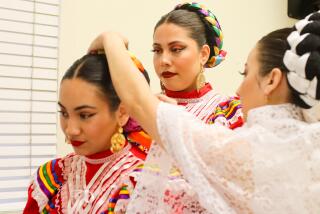Flamenco revisits its family roots
When people speak about the origins of flamenco, they usually emphasize the Andalusian caves and cantinas where outsiders first saw the art and where its stylistic priorities were honed. But before that, before percussive bravura dominated the dancing, flamenco was an expressive, improvisational form shared by Gypsy families in their homes.
Miguel Peña Vargas, a.k.a. El Funi, speaks about the old days while visiting his grandmother’s house on “Aires Gitanos,” a new CD-DVD package from Discmedi.
And this suave, 68-year-old guardian of tradition brought a sense of that time to the Gallery Theater in Barnsdall Art Park on Friday in a performance with the skillful Arte y Pureza Company from Seville, Spain.
Everyone danced in this seven-member company and nearly everyone sang. Dance passages often punctuated and ornamented vocalism, never more brilliantly than in El Funi’s Act 2 solos -- deft, light footed, suggesting more than displaying -- and the intense song-and-dance conversation between Fabiola Perez and Javier Heredia.
A guitar duet for Antonio Moya and company director Ethan Margolis also developed from individual statements to spontaneous interplay, though microphone feedback added nasty eruptions to their exemplary musicianship.
Barnsdall sight lines aren’t ideal for viewing footwork, but Cihtli Ocampo danced with such gestural flair and mastery of her long, ruffled train (kicking it behind her with every turn and sometimes up into her arms) that her Act 1 solo proved one of the evening’s highlights -- and her finale duet with El Funi (circling each other as if waiting to pounce) another.
Early in Act 2, Ocampo danced in a man’s suit, a break with flamenco tradition popularized nearly 75 years ago by the great Carmen Amaya. Moments of stillness added tension to the solo before outbursts of turns, high-velocity heel work or bold directional shifts provided new examples of her gutsy attack.
Among the singers, the high yet virile tone of Gabriel “Pies Plomo” added a distinctive edge to the performance, 80% of which was reportedly improvised. Certainly, the members’ rapt attention to every facet of El Funi’s art conveyed deep love and respect for the man.
Flamenco events are often refreshingly off the cuff, but this one made an especially strong case for jettisoning the way folklore is usually presented on our stages.
Early in the 20th century, the dance audience was a ballet audience, so the pioneers of theatricalized folklore used ballet as a model for their choreography and staging formats. But the audience they developed no longer needs the unison and large-scale spectacle their companies keep purveying.
People are now clearly willing to prize such intimate, improvisational ensembles as Arte y Pureza. Now if we could only get rid of the amplification.
--
More to Read
The biggest entertainment stories
Get our big stories about Hollywood, film, television, music, arts, culture and more right in your inbox as soon as they publish.
You may occasionally receive promotional content from the Los Angeles Times.










